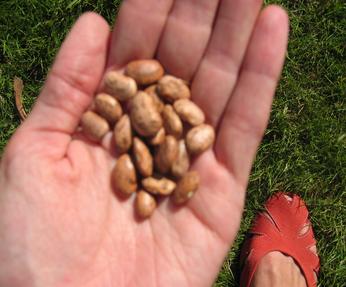Guest post by Emira Mears
Last week, said friend and I were having a drink and discussing the ups and downs of local eating. He happens to be something of a literal expert on the subject and is a true wealth of info on all foodstuffs local. In my dream universe of local eating, life would work as follows: I’d have the time to tend a very large garden that would allow me to support most of our fresh fruit and veggie needs in the backyard; I would can and preserve like a 60 year old Nonna for the winter months; I would supplement my own crop with the bounty of my grandma’s backyard; I’d get the odd harvest from the Farmer’s Market to stock up on things like blueberries and flour; and, we’d indulge in the odd tasty exotics from the Italian deli up the way. (This might not be Martin’s ideal, but he types too slowly to butt in). The biggest thing missing there, aside from canned legumes from the deli, would be sources of protein. I’ve always kind of assumed that save being able to raise goats for cheese, or maybe having a hen house for eggs (something I’m actually increasingly finding myself daydreaming about which is so very ridiculous that I laugh at my own daydreams), that there weren’t that many local resources for vegetarian protein. And here is where the hard beans came in. According to the local expert, it would seem that you can successfully grow hardbeans in this climate. With abandon! Who knew? (Likely many people, just not me). I always thought that our climate was limited to the regular green, wax and odd purple bean for eating at their young and fleshy stage.
My enthusiasm for the hard bean growing project was such, that my friend dropped off a wee paper packet containing some pinto beans this afternoon. Fun times. According to the somewhat bombastically labelled package, the "spotted rooster" bean that I’m holding in my hand there hails from Peru and is over 7,000 years old.

A friend came by the office today and dropped off a wee package of GE Free "Spotted Rooster" pinto beans which I’m pretty damn excited about growing.
I’m going to take advantage of the current warm season and get these little dudes in the ground quickly probably on Sunday morning to coincide with the new moon for good luck. I’d like to end up with enough of them to harvest some beans for storing, which may mean going outside of my two square containers. I may just fill up the empty spots in the flowerbeds with a few bush beans, and then pot some. If we can hurry up and eat tonnes of lettuce, I should also be able to squeeze in a square or two.
So thanks James! We’ll see how much protein we can grow here in East Vancouver.
Oh those beans sound exciting. I am completely drawn to growing certain varieties for their backstories. I’m growing a variety called ‘Baie Vert’, a bean that the early Acadian settlers got from local natives. It’s a white kidney bean.
Your lettuce will be done in no time. I don’t know what the weather is like there but we’re getting full-on heat and sun summer now and the lettuce is bound to start bolting.
What zone are you in? I am interested in this as well. I’m down south here in 7b.
I’m a 6b/7a type zone (different things tell me differently), so you should be fine! If anything you need warmer temperatures from what I know.
Gayla, I’m thinking if this succeeds I’ll definitely save seeds and send’em along, so maybe I’ll send you some Peruvian Pintos in exchange for some of your Baie Vert next year?
How do you save beans for future planting? Just put ’em in a packet and wait? Or do they need to be dried in some way? Or kept from drying? I don’t seem to be able to find the right words to use to search on this.